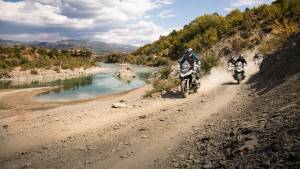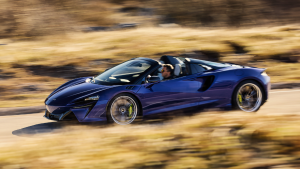TVS Apache RR 310 vs KTM RC 390 comparison test
The idea for this comparison test was seeded a little over two years ago. At the 2016 Auto Expo to be precise, when the TVS Akula 310 concept broke cover. The bike wasn't even revealed in production form till three months ago but we all knew this is the motorcycle that will take the KTM RC 390, the king of the premium sportsbike segment, head on. Of course, I don't need to tell you the Apache RR 310 is about 10PS down on the KTM and isn't as hardcore, which sounds like a disadvantage.
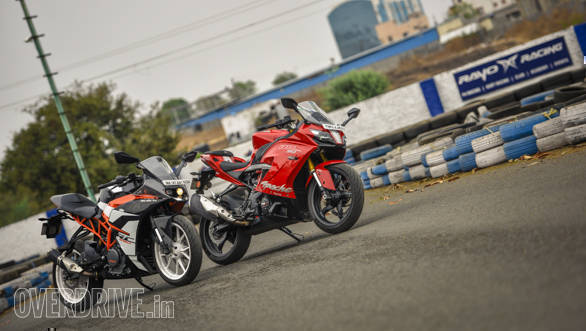 The KTM RC 390 looks smaller and sleeker, but the TVS makes a bigger impressions with its larger dimensions
The KTM RC 390 looks smaller and sleeker, but the TVS makes a bigger impressions with its larger dimensions
But after riding the RR 310 at the MMRT I was convinced that despite its friendlier nature and lesser outputs the bike is potent enough to challenge the relentless RC 390. KTM India being unable to give us a test bike meant this comparison test had to wait, until we found someone willing to loan his RC 390. So here it is, after testing both bikes in the city, on highways and a karting track as well! But before we get to the juicy bits of this test...
Design
The RC 390 only received revised decals as part of its update last year and the design is beginning to look dated, though it still has a lot of appeal with its aggressive stance. The RC also looks really compact. The RR 310 is larger in size the tank is wider and the fairing and windscreen are bigger which makes it feel like a higher capacity motorcycle. I also like the RC 390's side slung exhaust better as it looks sleeker. Personally, I prefer the cleaner look of the Apache's trellis chassis and rear subframe though, as also the tail lamp design. On the whole, the RR 310 looks better and appeals to a wider audience. The quality of paint and plastics on the RR 310 are also a lot more premium which makes it the better finished motorcycle here.
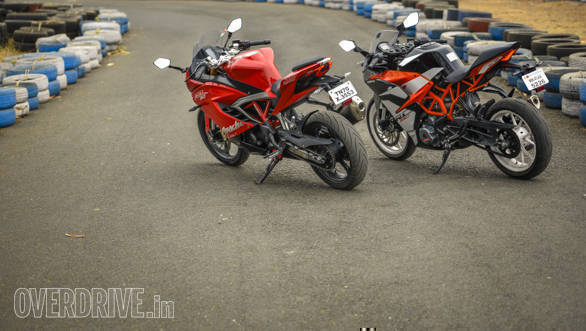 The TVS Apache RR 310 looks slightly more bulbous from the rear as compared to the KTM RC 390's chiselled lines
The TVS Apache RR 310 looks slightly more bulbous from the rear as compared to the KTM RC 390's chiselled lines
Engines
Both motorcycles use liquid-cooled single cylinder engines though the RR 310's cylinder is inclined towards the rear for mass centralisation and better handling. The RC 390 offers 43.5PS and 35Nm as opposed to the RR 310's 34PS and 27.3Nm which means the Apache is at a massive disadvantage on paper, not to mention its higher kerb weight of 169.5kg. KTM has only indicated the RC 390's dry weight of 147kg, and given its tank capacity of 10 litres the RC 390 should have a weight advantage over the Apache which also translates to a better power to weight ratio.
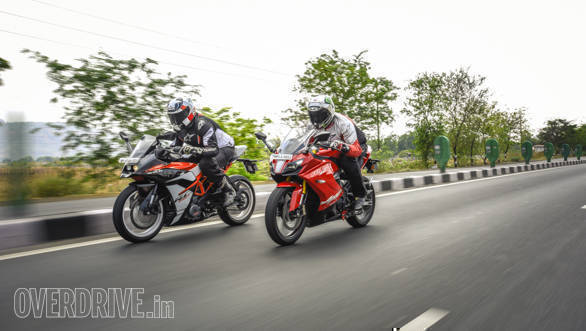 The KTM RC 390 isn't just more powerful, it is also lighter than the TVS Apache RR 310 which translates to a far superior power to weight ratio
The KTM RC 390 isn't just more powerful, it is also lighter than the TVS Apache RR 310 which translates to a far superior power to weight ratio
Equipment
Both boast fully-digital instrument clusters but the RR 310's vertically stacked instrument cluster looks unique and offers more information it's almost like the menu options don't end. Heck, it includes a 0-60kmph timer as well, which is addictive! The KTM console offers ample information but looks dated and smaller. Both get ABS as standard and braking is where the RC 390 claws back some advantage with a bigger, 320mm front disc (300mm on the Apache) and switchable ABS. Additionally, the KTM also gets an electronic ride-by-wire and a slipper clutch. That is a lot of equipment both motorcycles pack in. And now that I've got the boring stuff out of the way, let's get to the riding bit!
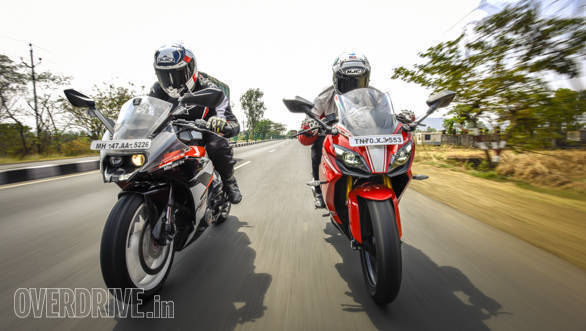 Out on the highway, there's no two ways about the TVS Apache RR 310 being far more comfortable than the KTM RC 390
Out on the highway, there's no two ways about the TVS Apache RR 310 being far more comfortable than the KTM RC 390
Highway
Both bikes were ridden from Mumbai to Pune and back, and the 400-odd kilometres made for some interesting findings. With its higher outputs and better top end the RC 390 feels quicker, especially when overtaking or accelerating through gears. There's a noticeable thrust at 7,000rpm which I won't deny is smile inducing. It's almost like the RC 390 turns into a different motorcycle, and once the power kicks in you don't even mind the cumbersomeness of the committed ergonomics while engine vibration almost disappears as well.
But, if you thought the Apache RR 310 would feel significantly slower, you are wrong! The Apache is up there with the KTM and there is no dearth of performance despite the power deficit. Thanks to the gearing and linear torque curve the RR 310 feels stronger at low to mid revs and you don't have to wait for the power to kick in, so there's always enough shove to help it keep up with the KTM on open roads. The Apache has vibration that comes in from the seat and footpegs but it isn't too much. All said and done, the RC 390 will probably stay ahead over distances but RR 310 never feels like it will have trouble keeping up.
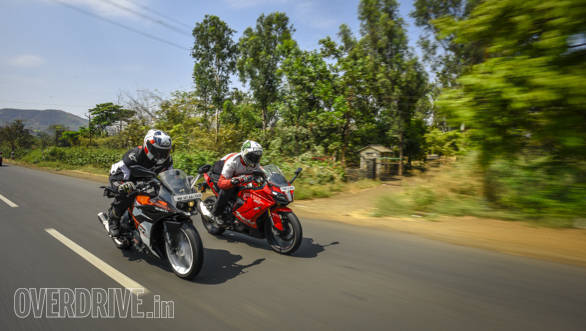 Despite the power deficit, the TVS Apache RR 310 never feels like it is at a disadvantage in terms of performance as compared to the KTM RC 390
Despite the power deficit, the TVS Apache RR 310 never feels like it is at a disadvantage in terms of performance as compared to the KTM RC 390
Both motorcycles are effortless cruising at triple digit speeds and neither will have trouble doing 130kmph or even more all day. Then there's the ergonomics. The RC 390's committed riding position takes a tolls on your wrists and back, as a lot of your body weight is on your wrists almost all the time and footpegs are rear set, which made me want to stretch my legs intermittently. In comparison you sit more upright on the RR 310 as the clip-ons are placed higher and closer to you while footpegs aren't as rear set. In fact, the RR 310 almost feels like a commuter after the RC 390!
The KTM is thus no match for the TVS when it comes to comfort on the highway. The RC 390's seat is also firmer which makes it uncomfortable over longer durations as compared to the RR 310's seat with its softer padding. The RC 390's stiffer suspension feels good on smooth roads but the setup eventually causes more fatigue. The RR 310's suspension is firm but more absorbent, which makes it better suited to our kind of roads. The Apache RR 310 is thus the bike I'd want to take for a long ride, though I cannot deny the RC 390 is a lot of fun when grabbed by the scruff of its neck.
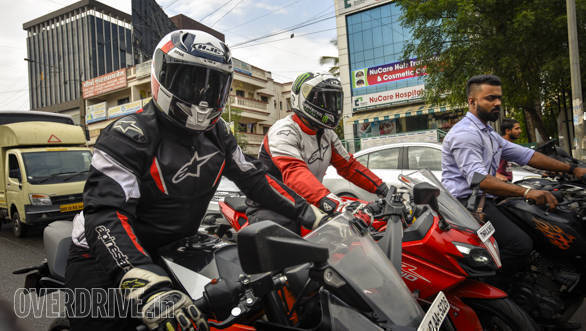 The KTM RC 390's super-committed riding position means you end up loading your wrists a lot of times in city traffic, given that you are needed to brake constantly
The KTM RC 390's super-committed riding position means you end up loading your wrists a lot of times in city traffic, given that you are needed to brake constantly
City
Most of my seat time on the RC 390 in city was accompanied by a whining sound as the radiator fan is running almost all the time! With its high strung motor the KTM isn't too happy at slow speeds and expresses its displeasure by spewing hot air onto the rider's legs. The Apache's radiator fan does not come on as frequently and doesn't stay on for too long either thanks to the ducts designed into the fairing that dissipate heat more efficiently. Also, the air is channeled away from the rider's legs on the Apache and you barely feel any heat, making it more comfortable in traffic.
The KTM's committed riding position is more manageable in city than on the highway, but you still end up loading your wrists. The Apache's upright stance means your wrists are a lot happier while the softer seat makes for a plusher feel. The difference between their suspension setups can be felt in city too the KTM transfers shocks to the rider when going fast over bumps and potholes. The Apache has a sense of firmness to it but feels more pliant.
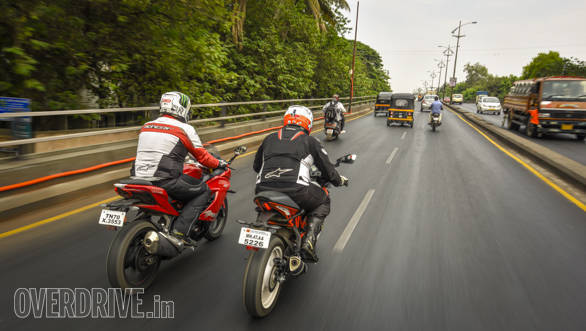 The KTM RC 390's radiator fan stays on almost all the time in city traffic - that's how high strung its engine is in comparison to the TVS Apache RR 310's
The KTM RC 390's radiator fan stays on almost all the time in city traffic - that's how high strung its engine is in comparison to the TVS Apache RR 310's
Coming to performance and handling in city, the Apache RR 310 is at an advantage again, thanks to its stronger bottom end. In fact there were times when it actually felt quicker to maneuver as its handlebars offered better leverage. There's more shove from the TVS engine even at crawling speeds unlike the KTM that does not offer as much thrust. One issue with the Apache RR 310 in traffic is the length of its mirror stalks, and I had to keep an eye on the mirrors when cutting through traffic to ensure they didn't touch other vehicles. This isn't as much of an issue on the KTM.
There's a noticeable change in the way the two stack up against each other in sparse traffic though. Think of an early morning ride through the city when there's barely any vehicles on the road. The KTM comes into an element of its own and feels faster, quicker to maneuver and more sure footed with its Metzeler tyres. The Apache's Michelins offer as much grip but confidence levels are a shade lower around fast bends, especially when getting on or off flyovers. The KTM also scurries ahead with an urgency the Apache cannot really match when taking off traffic lights. The RC 390's ride-by-wire throttle also makes for better precision at speeds, though I found the RR 310's fuelling to be smoother at low speeds.
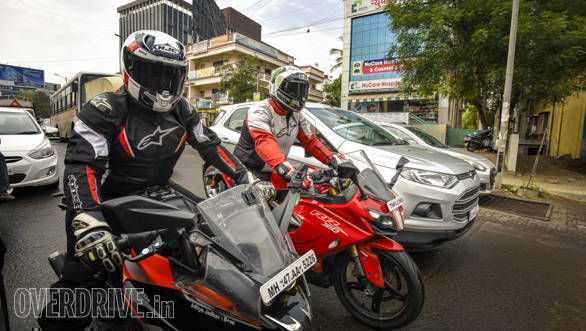 The KTM RC 390 will have no trouble showing the TVS Apache RR 310 a clean pair of heels at every traffic light given its higher outputs and lower weight
The KTM RC 390 will have no trouble showing the TVS Apache RR 310 a clean pair of heels at every traffic light given its higher outputs and lower weight
I had Anis, our staff photographer hop on as pillion on both bikes and he was quick to note that the Apache's seat was smaller but more comfortable, as the contours of the RC 390's pillion seat make it difficult to find a sweet spot. Riding at night, the Apache's LEDs offer a brighter, better spread of light, but the RC 390 offers a longer throw. I found the Apache's lights to offer more confidence on unlit roads despite the shorter throw as I could see more of the sides of the road. To sum it up here, the scores in city aren't very different. The Apache still feels more comfortable with better heat management and a more pliant ride while offering enough grunt, though the RC 390 closes in a lot more this time with its engaging experience.
Karting track
Indikarting is a karting circuit on the outskirts of Pune, managed by Rayomand Banajee of Rayo Racing. Karting tracks mean slow, tight corners making for a great maneuverability test. And surprisingly, the Apache RR 310 felt nearly identical in experience to the KTM. Had this been a full-fledged racetrack the RC 390 would have had a significant advantage but a more committed riding position and top end-y power delivery didn't really help it at the karting track.
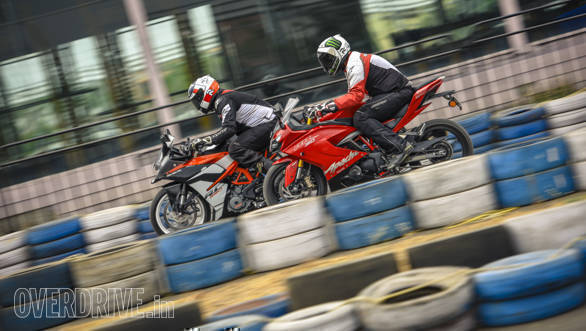 Interestingly, the TVS Apache RR 310 felt as natural and effortless on the karting track as the KTM RC 390
Interestingly, the TVS Apache RR 310 felt as natural and effortless on the karting track as the KTM RC 390
The Apache's handlebars offered better leverage and quicker turn ins which coupled with the stronger bottom end performance made it quick through corners. Going through a series of bends the Apache thus felt slightly quicker, but the main straight is where the KTM was quicker and leveled it out overall. The Apache's brakes offer good bite with a more progressive feel as compared to the RC 390. The KTM offers lots of bite instantly which could get unnerving for lesser experienced riders, despite the safety net from the ABS.
Track surface wasn't the best but both bikes offered good grip levels. The surface was also slightly bumpy which gave the RR 310 an advantage. Its suspension helped it maintain composure by soaking up mid-corner bumps unlike the RC 390 that was prone to getting unsettled. Last but not the least, the RR 310's clutch is also lighter. The karting track was where we ended the day after riding on the highway and in city and the Apache's lighter clutch called for lesser effort at the lever than the RC 390's, which felt heavier in comparison.
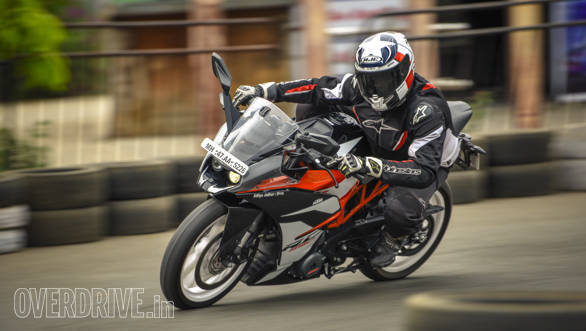 The KTM RC 390's stickier Metzeler tyres do make a difference when pushing around corners
The KTM RC 390's stickier Metzeler tyres do make a difference when pushing around corners
Verdict
A full day of riding over 400km across various riding conditions was good enough to assess the Apache RR 310 and RC 390. I was expecting a wider gap, at least in terms of performance and handling, but the RR 310 is up there with the RC almost all the time. And that's despite being heavier and less powerful! The gap in terms of comfort wasn't as surprising as we've always known the KTM RC 390 is a no holds barred, hardcore sportsbike built for outright performance and razor sharp handling. The RC 390 is akin to a surgical scalpel in that sense, while the Apache RR 310 is more like a Swiss knife it does the job without any hiccups and can multitask as well.
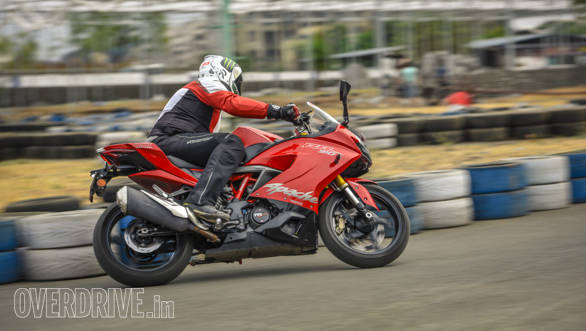 The TVS Apache RR 310 is like a Swiss knife and performs well in almost every environment, without disappointing
The TVS Apache RR 310 is like a Swiss knife and performs well in almost every environment, without disappointing
And you'd rather buy a Swiss knife that's practical enough to be used for various purposes rather than go in for a scalpel that has just one intent, no? That's something that truly swings my vote in the RR 310's favour, though I'd be lying if I said I didn't enjoy thrashing the RC 390 more on the highway and around fast corners. The Apache RR 310 also boasts a better build quality along with more premium fit-finishes which further tilts the scales in its favour. What seals the deal though is the difference in pricing. At Rs 2.36 lakh on road Mumbai the Apache RR 310 costs about Rs 40,000 less than the RC 390 that retails at Rs 2.72 lakh on road. Need I say more?
Photography by Anis Shaikh
Starts Rs 2,40,000
313cc
6-Speed
34.00
27.30
-NA-
Starts Rs 3,14,000
373cc
6-Speed
43.00
37.00
-NA-
